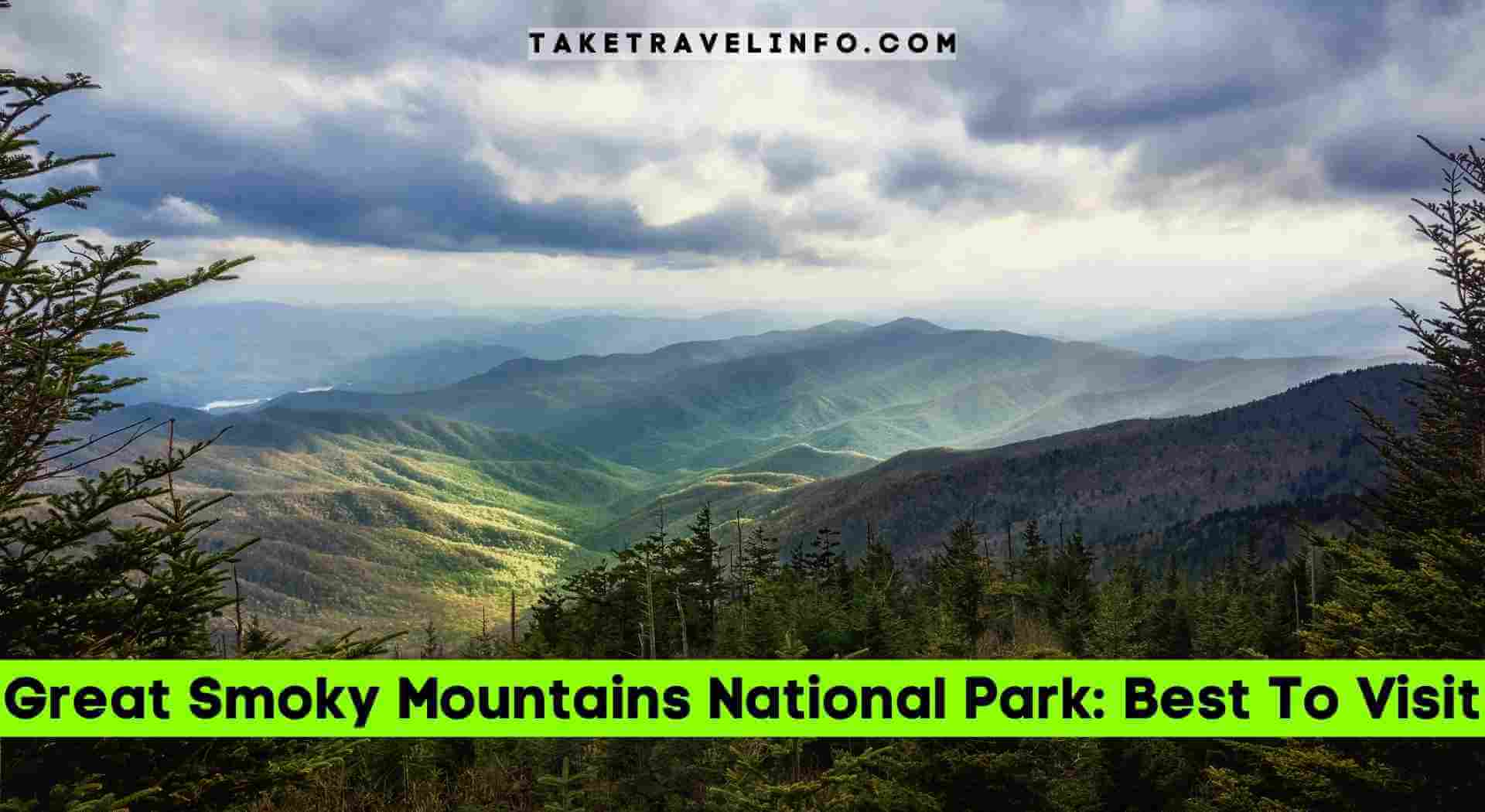Great Smoky Mountains National Park is a sprawling national park that spans across the border of North Carolina and Tennessee, featuring lush forests, wildflowers, and stunning hiking routes with streams, rivers, and waterfalls. The park is home to Clingmans Dome, the highest peak, which offers breathtaking views of the mist-covered mountains.
Established on June 15, 1934, the park covers an area of 522,419 acres. It attracts millions of visitors annually, making it one of the most popular national parks in the United States. Whether you’re a nature lover, hiker, or photographer, Great Smoky Mountains National Park offers endless opportunities for outdoor exploration and adventure.
The Beauty Of Great Smoky Mountains National Park
Great Smoky Mountains National Park, situated on the border of North Carolina and Tennessee, showcases stunning natural beauty with its lush forests, blooming wildflowers, and picturesque waterfalls. Hiking routes, including a section of the Appalachian Trail, provide opportunities to explore the park’s scenic landscapes, while Clingmans Dome offers panoramic views from its observation tower.

Nestled in the heart of the Appalachian Mountains, Great Smoky Mountains National Park is a breathtakingly beautiful destination that attracts millions of visitors each year. With its diverse ecosystems, stunning landscapes, and rich biodiversity, this national park offers a wide range of natural wonders to explore.
From towering peaks and majestic waterfalls to vibrant wildflower meadows and ancient forests, the beauty of the Great Smoky Mountains National Park is truly awe-inspiring.
Overview Of The Park’s Natural Beauty
- Mountains and Valleys: Great Smoky Mountains National Park is home to some of the highest peaks in the eastern United States, including Clingmans Dome, which stands at an impressive elevation of 6,643 feet. These mountains provide a stunning backdrop for the park’s scenic valleys, creating a picturesque landscape that is truly one-of-a-kind.
- Waterfalls: One of the park’s most iconic features is its numerous waterfalls. From the majestic Grotto Falls, where you can hike behind the cascading water, to the powerful Roaring Fork Falls, there is no shortage of spectacular falls to discover. The sound of rushing water combined with the lush green surroundings creates a tranquil and enchanting atmosphere.
- Wildlife: The park is renowned for its abundant wildlife, making it a paradise for nature enthusiasts. Visitors may catch a glimpse of black bears, elks, white-tailed deer, and a variety of bird species. Exploring the park’s trails and scenic drives provides endless opportunities for wildlife sightings and photography.
- Flora and Fauna: Great Smoky Mountains National Park is home to an astounding diversity of plant and animal species. Its lush forests are carpeted with delicate wildflowers in the spring, vibrant foliage in the fall, and evergreen trees year-round. The park’s unique combination of temperate rainforest and deciduous forest creates an environment that supports a wide array of flora and fauna.
- Scenic Drives: For those who prefer to take in the beauty of the park from the comfort of their car, the park offers several scenic drives. The breathtaking views along Newfound Gap Road and Cades Cove Loop Road are must-sees. These drives take visitors through some of the park’s most picturesque landscapes, offering panoramic vistas and opportunities for wildlife spotting along the way.
Unique Features And Attractions
- Appalachian Trail: Great Smoky Mountains National Park is a part of the legendary Appalachian Trail, a 2,190-mile-long hiking trail that stretches from Georgia to Maine. Hiking a portion of this iconic trail allows visitors to experience the park’s rugged beauty up close and personal.
- Cades Cove: Cades Cove is a historic valley nestled within the park. It is a prime spot for wildlife viewing, as well as exploring the remnants of the area’s early settlers. The picturesque loop road takes visitors on a journey through time, where they can see preserved cabins, churches, and other structures dating back to the 19th century.
- Synchronous Fireflies: Great Smoky Mountains National Park is famous for its annual synchronized firefly display, a natural phenomenon where thousands of fireflies flash in unison. This mesmerizing event occurs for a few weeks in late spring or early summer and draws visitors from all over the world.
- Auto Touring: The park offers a wide variety of auto touring options, allowing visitors to explore its beauty at their own pace. From scenic drives like the Blue Ridge Parkway to shorter drives like the Roaring Fork Motor Nature Trail, there are options for every type of traveler.
- Water Activities: Great Smoky Mountains National Park is a paradise for water enthusiasts. Visitors can enjoy activities such as fishing, tubing, and swimming in the park’s crystal-clear streams and rivers. Whether you’re a seasoned angler or just want to cool off on a hot summer day, the park’s waterways offer endless possibilities for fun and relaxation.
The beauty of the Great Smoky Mountains National Park is unparalleled. Its majestic mountains, stunning waterfalls, diverse flora and fauna, and unique attractions make it a must-visit destination for nature lovers. Exploring the park’s natural wonders will leave you with memories that will last a lifetime.
So pack your hiking boots, grab your camera, and get ready to immerse yourself in the unparalleled beauty of the Great Smoky Mountains National Park.
Wildlife In Great Smoky Mountains National Park
Great Smoky Mountains National Park, located on the border between North Carolina and Tennessee, is home to diverse wildlife and breathtaking natural beauty. The park boasts lush forests, colorful wildflowers, and numerous streams and waterfalls. Hiking trails, including a portion of the Appalachian Trail, allow visitors to explore the park’s stunning scenery and observe its abundant wildlife.

Abundance Of Diverse Wildlife Species:
- Great Smoky Mountains National Park is famous for its rich and diverse wildlife population.
- The park is home to over 65 species of mammals, including black bears, white-tailed deer, elk, raccoons, and skunks.
- It is also a habitat for more than 200 species of birds, such as the eastern bluebird, wild turkey, and pileated woodpecker.
- The park’s diverse ecosystems, including forests, meadows, and rivers, provide a range of habitats for these wildlife species to thrive.
Importance Of Wildlife Conservation In The Park:
- Wildlife conservation plays a vital role in maintaining the ecological balance of Great Smoky Mountains National Park.
- The park’s rich biodiversity is not only a natural treasure but also contributes to the overall health of the surrounding ecosystem.
- By protecting wildlife species, the park ensures the preservation of native plants and animals, promoting a sustainable habitat for future generations.
- Conservation efforts in the park aim to reduce human-wildlife conflicts and maintain the park’s natural beauty and biodiversity.
Popular Wildlife Viewing Areas And Opportunities:
- Cades Cove is one of the most popular areas within the park to spot wildlife. Visitors often see white-tailed deer, black bears, and turkeys in this scenic valley.
- Cataloochee Valley is another prime location for wildlife viewing, especially elk. Elk were reintroduced to the park in 2001, and their population has thrived in this area.
- Clingmans Dome, the highest point in the park, offers breathtaking views and a chance to spot birds such as the northern saw-whet owl and the Blackburnian warbler.
- The Roaring Fork Motor Nature Trail is a scenic drive that provides opportunities to see black bears, deer, and other wildlife along the way.
- Visitors can also explore the park’s numerous hiking trails, such as the Laurel Falls Trail or the Alum Cave Trail, where they may encounter various wildlife species.
Remember to make sure that all the content is engaging, concise, and easily understandable. Use active voice, and natural language, and avoid repetitive terms or overused phrases.
Hiking And Outdoor Activities In Great Smoky Mountains National Park
The Great Smoky Mountains National Park is a hiker’s paradise, offering a wide range of trails for all skill levels. In this section, we will explore the extensive trail system, popular hikes, and outdoor activities available in the park. Before embarking on your adventure, it’s important to familiarize yourself with safety tips and guidelines to ensure a memorable and safe experience.

Extensive Trail System For All Skill Levels:
- The park boasts over 800 miles of trails, catering to hikers of all abilities.
- The trails range from easy, paved paths suitable for families and individuals with limited mobility to strenuous hikes that will challenge even the most experienced hiker.
- Each trail offers unique scenery, from breathtaking vistas to serene creeks and waterfalls.
- When selecting a trail, consider factors such as distance, elevation gain, and difficulty level, to choose a route that suits your preferences and fitness level.
Popular Hikes And Outdoor Activities In The Park:
- Clingmans Dome: This iconic trail leads to the highest peak in the park, offering panoramic views of the surrounding mountains. The trail is paved, making it accessible for visitors of all ages.
- Alum Cave Trail: This moderate hike takes you through a stunning rock formation known as Alum Cave. Along the way, you’ll pass scenic overlooks and a striking waterfall.
- Grotto Falls: Located along the Roaring Fork Motor Nature Trail, this easy hike leads to a beautiful waterfall that you can walk behind, creating a truly immersive experience.
- Mt. LeConte: For the more adventurous hikers, the trail to Mt. LeConte offers a challenging trek with rewarding views. The route can be accessed from various trailheads and offers overnight lodging options at LeConte Lodge.
- Wildlife Spotting: Great Smoky Mountains National Park is home to a diverse range of wildlife, including black bears, deer, elk, and numerous bird species. Keep your eyes peeled and your camera ready for potential wildlife sightings.
Safety Tips And Guidelines For Hiking And Exploring The Park Trails:
- Stay on designated trails: To protect the delicate ecosystem and your safety, it’s crucial to stick to marked paths and avoid venturing off-trail.
- Carry essential supplies: Always pack plenty of water, snacks, a map, and a compass or navigation device. Be prepared for changing weather conditions by bringing appropriate clothing and gear.
- Inform others of your plans: Before setting off on a hike, let someone know your intended route and estimated return time. This ensures that someone can raise the alarm if you encounter any difficulties.
- Check the weather: Before heading out, check the weather forecast and be aware of any potential hazards, such as heavy rain or thunderstorms. It’s advisable to reschedule your hike if severe weather conditions are expected.
- Respect wildlife: Keep a safe distance from wildlife and never feed or approach them. Remember, the park is their natural habitat, and our presence should have minimal impact.
- Leave no trace: Help preserve the beauty of the park by disposing of waste properly and leaving nature untouched. Respect the “Leave No Trace” principles and pack out whatever you pack in.
Whether you’re a seasoned hiker or a beginner, the Great Smoky Mountains National Park offers an abundance of trails and outdoor activities to satisfy your adventurous spirit. By following safety guidelines and respecting the park’s natural environment, you can explore the park’s wonders while creating lasting memories.
Lace up your hiking boots and get ready for an incredible outdoor experience in the Smokies!
Planning A Visit To Great Smoky Mountains National Park
The Great Smoky Mountains National Park is a breathtaking destination that attracts millions of visitors each year. If you’re planning a visit to the park, there are a few important things to consider. From the best time to visit to transportation options and camping/accommodation choices, this guide will help you make the most of your trip.

Best Time To Visit The Park:
- Spring (March to May): This is a popular time to visit the park as wildflowers are in full bloom, and the weather is pleasant. However, keep in mind that the park can get crowded during weekends and holidays.
- Fall (September to November): The park’s foliage turns into vibrant shades of red, orange, and gold, making it a perfect time for nature lovers and photographers. The weather is also cool and comfortable during this time.
- Winter (December to February): While the park receives snowfall during winter, it offers a serene and peaceful atmosphere. If you enjoy winter sports like skiing or snowshoeing, this is the perfect time for you.
- Summer (June to August): Although summer is the peak tourist season, it’s a great time for hiking, camping, and enjoying the park’s numerous waterfalls and swimming holes. Just be prepared for the heat and occasional afternoon thunderstorms.
How To Get To The Park And Transportation Options:
- By Car: The Great Smoky Mountains National Park can be reached by car from various directions. The park has entrances in Tennessee and North Carolina, and the most popular entry points are through Gatlinburg, Tennessee, and Cherokee, North Carolina.
- By Air: The closest major airports to the park are McGhee Tyson Airport (TYS) in Knoxville, Tennessee, and Asheville Regional Airport (AVL) in Asheville, North Carolina. From there, you can rent a car or take a shuttle service to reach the park.
- By Bus: The park is not directly accessible by public transportation, but you can take a bus to nearby towns like Gatlinburg or Asheville and then arrange for a shuttle service or taxi to the park.
- By Train: Although there is no train station within the park, you can take an Amtrak train to cities like Knoxville or Asheville and then continue your journey by rental car or shuttle service.
Camping And Accommodation Options Within The Park:
- Camping: Great Smoky Mountains National Park offers several campgrounds that are open year-round. These campgrounds provide basic facilities such as restrooms, picnic tables, and fire grates. Some campgrounds also have showers and laundry facilities. Reservations are recommended, especially during peak seasons.
- Backcountry Camping: For those seeking a more adventurous experience, backcountry camping is permitted in designated areas of the park. You’ll need a permit, which can be obtained at the park visitor centers.
- Lodging: If camping is not your preference, there are also lodging options available both inside and outside the park. Inside the park, you can find historic lodges and cabins. Outside the park, there are numerous hotels, motels, cabins, and vacation rentals in nearby towns like Gatlinburg, Townsend, and Cherokee.
Whether you’re looking to explore the park’s stunning natural beauty, go hiking, wildlife spotting, or simple relaxation, planning your visit to Great Smoky Mountains National Park is essential. Consider visiting during the best time for your preferred activities, choose the transportation option that suits your needs, and book your desired camping or accommodation option in advance to ensure a memorable and enjoyable experience.
Frequently Asked Questions On Great Smoky Mountains National Park
Why Is Great Smoky Mountains National Park So Famous?
The Great Smoky Mountains National Park is famous for its lush forests, diverse wildlife, and stunning waterfalls.
What Is The Most Visited Park In The Smoky Mountains?
The most visited park in the Smoky Mountains is Great Smoky Mountains National Park.
Can You Just Drive Through Smoky Mountain National Park?
Yes, you can drive through Smoky Mountain National Park.
How Many Days Do You Need In Great Smoky Mountain?
You need at least a few days to explore the Great Smoky Mountains National Park.
Conclusion
As one of the largest protected areas in the eastern United States, the park’s sprawling landscape provides an opportunity for endless exploration. Whether you’re a seasoned hiker or simply looking to connect with nature, the Great Smoky Mountains National Park is a must-visit destination.
Immerse yourself in the tranquility of this natural wonderland and create memories that will last a lifetime. Plan your trip now and discover why this park is truly a national treasure.


2 thoughts on “Great Smoky Mountains National Park: Best To Visit”